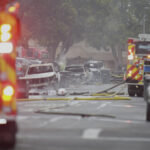A debris flow and flash flood warning system developed jointly by NOAA’s National Weather Service and the U.S. Geological Survey will help protect Southern Californians from potentially devastating debris flows — commonly known as mud slides — and flash floods in and around burn areas created by the recent wildfires.
“Much of the smoke has cleared from the region’s devastating wildfires last month, but the danger is not over,” said Jack Hayes, director of the National Weather Service. “Moderate amounts of rainfall on a burned area can lead to flash floods and debris flows. The powerful force of rushing water, soil, and rock can destroy everything in its path, leading to injury or death.”
“Our science can help determine the location, size and occurrence of potentially destructive debris flows and floods from last month’s Southern California wildfires,” said USGS Director Mark Myers. “The public, emergency managers and policymakers can use this information to prepare for and react to these potentially devastating natural hazards.”
Post-wildfire debris flows are closely linked to precipitation and are therefore more predictable than other landslides. The USGS has developed precipitation thresholds that help identify potential debris flows in recent burn areas and provides this information to National Weather Service forecast offices in Southern California. Using a flash flood monitoring and prediction tool, weather forecast offices monitor rainfall, and if it approaches the thresholds developed for burn areas, incorporate wording about debris flow hazards into flash flood warnings and public information statements. Flash flood warnings are communicated to the public through the Emergency Alert System and NOAA Weather Radio-All Hazards, and directly to local emergency managers.
Even before the fires started, the agencies agreed to extend for another year the debris flow and flash flood warning system pilot project started in September 2005. In a 2005 report, the agencies outlined the initial plan for the project, identified the need to expand the warning system nationwide and focused on developing improved technologies to characterize flash flood and debris flow hazards.
The project will continue to cover San Luis Obispo, Santa Barbara, Ventura, Los Angeles, San Bernardino, Orange, Riverside, and San Diego counties, most of which were affected by the recent wildfires.
For more information, visit
NOAA: http://www.noaa.gov
NOAA’s National Weather Service: http://www.weather.gov
Information on post-fire debris flows: http://landslides.usgs.gov/research/wildfire
Sources: NOAA, USGS
Was this article valuable?
Here are more articles you may enjoy.

 Brazil Sues EV Giant BYD Over ‘Slavery’ Conditions at Plant
Brazil Sues EV Giant BYD Over ‘Slavery’ Conditions at Plant  Citi Reverses Course on Firing of Japan Trader Five Years On
Citi Reverses Course on Firing of Japan Trader Five Years On  Plane Crashes into San Diego Neighborhood, Setting Homes And Vehicles on Fire
Plane Crashes into San Diego Neighborhood, Setting Homes And Vehicles on Fire  Cyberattack Surge Creates Opportunity, Premium Rethink for Insurers
Cyberattack Surge Creates Opportunity, Premium Rethink for Insurers 